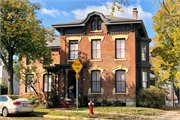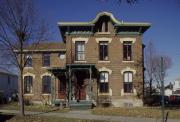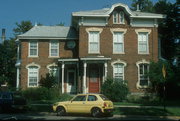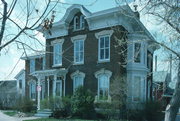Property Record
754 JENIFER ST
Architecture and History Inventory
| Historic Name: | John George & Lucia Ott House |
|---|---|
| Other Name: | R. Richard Wagner House |
| Contributing: | |
| Reference Number: | 16105 |
| Location (Address): | 754 JENIFER ST |
|---|---|
| County: | Dane |
| City: | Madison |
| Township/Village: | |
| Unincorporated Community: | |
| Town: | |
| Range: | |
| Direction: | |
| Section: | |
| Quarter Section: | |
| Quarter/Quarter Section: |
| Year Built: | 1873 |
|---|---|
| Additions: | 1914 |
| Survey Date: | 19822019 |
| Historic Use: | house |
| Architectural Style: | Italianate |
| Structural System: | |
| Wall Material: | Brick |
| Architect: | |
| Other Buildings On Site: | |
| Demolished?: | No |
| Demolished Date: |
| National/State Register Listing Name: | Ott, John George, House |
|---|---|
| National Register Listing Date: | 9/23/1982 |
| State Register Listing Date: | 1/1/1989 |
| National Register Multiple Property Name: |
| Additional Information: | MAP CODE IS 0709-134-2802-9. This ornate Italianate building was the home of John George Ott, a German-Swiss immigrant, businessman and civic leader. Madison Historic Landmark: 10/1/1979. ALSO IN JENIFER-SPAIGHT HISTORIC DISTRICT 07/16/2004 Third lake Ridge Historic District: A Walking Tour. 1987: John George "Ott (1837-1914) emigrated to Madison from Schaffhausen, Switzerland in 1850, at the age of 13. He began his career as a store clerk and later operated a grocery business on Williamson Street, at the rear of this property. From 1868 to 1872 he operated a brickyard, and during the years he lived in this house he sold insurance and real estate. Ott was active in the Old Settler's Club and the Turnerverein, the Madison Mannerchor, and the German Masonic Lodge. He is associated with the effort to make Orton Park Madison's first public park. This house was owned by his descendants until 1973. It probably was built of brick from Ott's own brickyard, and is trimmed with dressed and carved sandstone." City of Madison, Wisconsin Underrepresented Communities Historic Resource Survey Report: Roland Richard Wagner moved to Madison in 1965 and has been as a community leader, neighborhood pioneer, and LGBTQ historian since the early 1970s. After earning a Ph.D. from the University of Wisconsin in History, he was credited with advancing the passage of Madison’s Landmarks Ordinance in 1971. Then he served on and chaired the Madison commission that the ordinance created through 1979. He pioneered reinvestment in the deteriorated Marquette neighborhood by buying and restoring several houses in the neighborhood beginning in 1975. While he was investing in the neighborhood, he also served on its neighborhood association and advocated for a community-directed revitalization of the Williamson Street corridor. Wagner lived at 134 East Gorham Street until 1975. In 1980, Wagner was the first openly gay member elected to the Dane County Board of Supervisors, which he served on until 1994, serving as its chair for four terms. In his first year, the Dane County Board of Supervisors adopted a county-wide non-discrimination ordinance that offered protections to the LGBTQ community. During his time on the county board, he also played a major role in the advancement of Monona Terrace and Olbrich Gardens. In 1983, when he was one of about only twenty-five openly gay elected officials in the country, Wagner was appointed as one of the first co-chairs of Governor Tony Earl’s newly established Council on Lesbian and Gay Issues. Wagner resigned from the council in August 1984; before the council disbanded after Tommy Thompson’s election in 1986 due to his vowing during the campaign to eliminate the council. He has served on many other boards, committees, and commissions, including the Wisconsin American Revolution Bicentennial Commission from 1972 to 1976, the Citizen’s Advisory Committee to the Landmarks Commission in 1972, the Madison Landmarks Commission from 1973 to 1979, the Dan County Board of Supervisors from 1980 to 1994, the Governor’s Council on Lesbian and Gay Issues from 1983 to 1984, the Urban Design Commission from 207 to 2019, the East Rail Corridor Plan Advisory Committee from 2001 to 2004, and the Madison Plan Commission from 1997 to 2004. For more information on the life of Dick Wagner, please see the Notable People Chapter. Dick Wagner is locally significant in the LGBTQ community in the area of Government from 1980 to 1994. During this time period, there were several resources associated with him: The City-County Building at 210 Martin Luther King Jr. Boulevard, his 1975 to 1986 house at 754 Jenifer Street, and his 1986 to the present-day house at 739 Jenifer Street. Dick Wagner’s home at 739 Jenifer Street was not included in the survey as the life of David Clarenbach and his significance in the area of Government were more closely associated with other resources. |
|---|---|
| Bibliographic References: | TAX RECORDS. THE CAPITAL TIMES 10/12/1996. Third lake Ridge Historic District: A Walking Tour. 1997, Madison Landmarks Commission and the Madison Trust for Historic Preservation. Housing Madison: Where We Live, Where We Work. Ed. Anna Vemer Andrzejewski and Arnold R. Alanen for “Nature + City: Vernacular Buildings and Landscapes of the Upper Midwest,” 2012 Meeting of the Vernacular Architecture Forum (VAF). Third lake Ridge Historic District: A Walking Tour. 1987, Madison Landmarks Commission and the Madison Trust for Historic Preservation. |
| Wisconsin Architecture and History Inventory, State Historic Preservation Office, Wisconsin Historical Society, Madison, Wisconsin |





